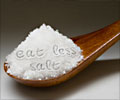Research finds a move from a traditional diet to the sodium-laden Western diet is fuelling a spike in the blood pressure of the Inuit in Canada's North
Dr. Marie-Ludivine Chateau-Degat has told the Canadian Cardiovascular Congress 2009 that a move from a traditional diet to the sodium-laden Western diet is fuelling a spike in the blood pressure of the Inuit in Canada's North. The congress is co-hosted by the Heart and Stroke Foundation and the Canadian Cardiovascular Society.
"This is a population currently undergoing a significant dietary transition away from their traditional diet − which includes large amounts of fish and marine products − to a Western diet," Dr. Chateau-Degat told the meeting. "Both diastolic and systolic blood pressures increased with amount of sodium consumed."Previous studies, she says, have reported low average blood pressures in several isolated communities, in part, she theorizes, from protective effect of traditional dietary habits which tend to be lower in dietary sodium.
Dr. Chateau-Degat says the consumption of Arctic store-bought foods has been shown to provide 95 per cent of the dietary sodium intake.
The contrast in dietary habits is remarkable. In 1992 a Santé Quebec health survey found that 21 per cent of the food consumed by Inuit adults was from traditional foods. In 2004 that percentage dropped to only 16 per cent.The study recruited 184 men and 237 women aged 18 to 70 years from 14 coastal villages in Nunavik, Quebec, north of the 55th parallel. Ninety four people were excluded because they were being treated for high blood pressure.Dietary sodium and nutrient intake were measured by questionnaire; blood pressure and body mass index (BMI) were also assessed.The great shiftThe Nunavik Regional Board of Health and Social Services estimates that, prior to the 1992 survey, fish and seafood were consumed nearly three times a week and caribou nearly twice a week. Wildfowl and marine mammal meat were consumed on average once a week. Nearly 88 per cent of household reported getting these 'traditional foods' from the community freezer.By 2004 'traditional food' consumption plummeted. Intakes of vitamins A, C, and D, calcium, and dietary fibre showed a dramatic reduction. At the same time, consumption of soda and fruit drinks was the main source of carbohydrates among young people."The intake of sweet foods is a major cause of obesity, a risk factor for diabetes and heart disease," warns Dr. Chateau–Degat. She says it is imperative that the Inuit – like all Canadians − cut down their consumption of soft drinks and prepackaged foods. "Salt is especially high in packaged foods," warns Heart and Stroke Foundation spokesperson Dr. Beth Abramson. "Three in 10 Canadians have been diagnosed with high blood pressure caused by eating too much salt. About one-third of Canadians are particularly sensitive to the effects of salt on their blood pressure. For these people, excessive salt increases the amount of blood in the arteries, raising blood pressure and putting them at risk for heart disease and stroke."Most of the sodium Canadians consume (77 per cent) comes from processed foods sold in grocery stores and in food service outlets.To help reduce added, unnecessary salt:
- Cut down on prepared and processed foods.
- Check the Nutrition Facts table on food products for sodium or salt content.
- Eat more fresh vegetables and fruit.
- Experiment with other seasonings, such as garlic, lemon juice, and fresh or dried herbs.
- Lower your salt intake little by little each day.
Source-Eurekalert
RAS














